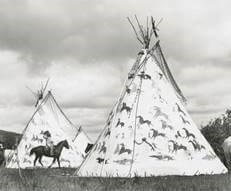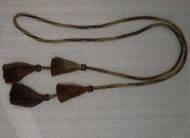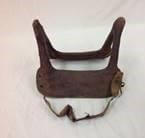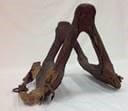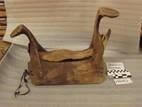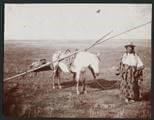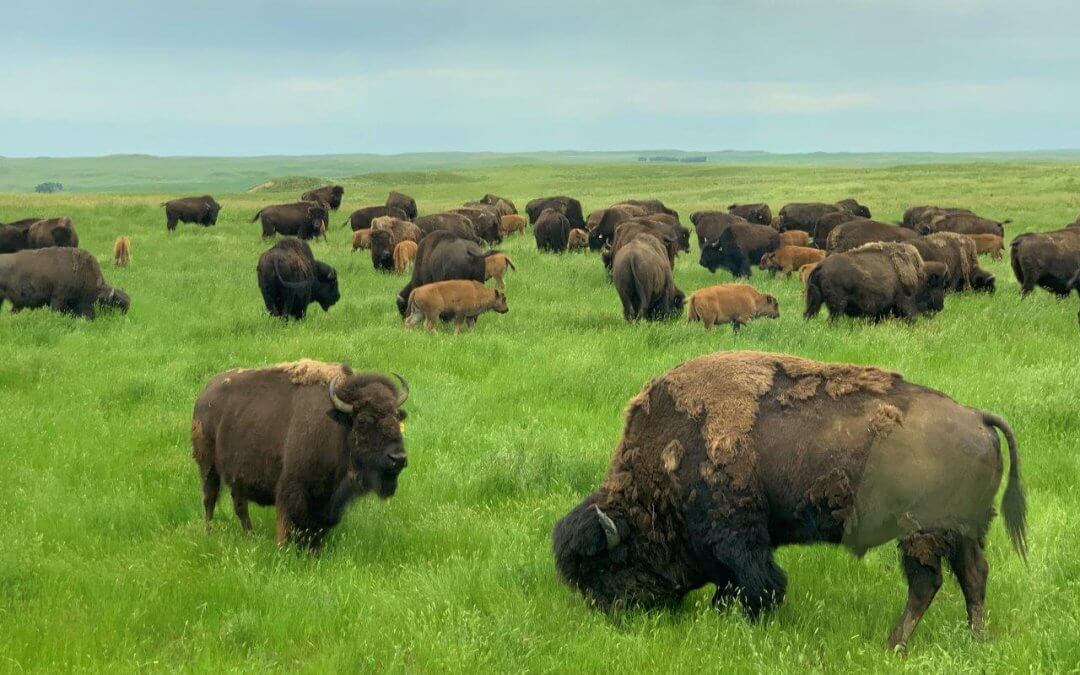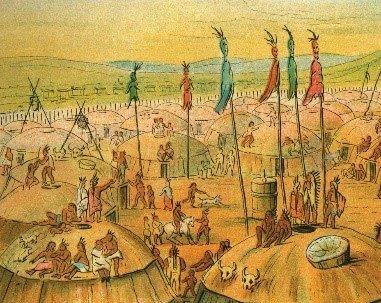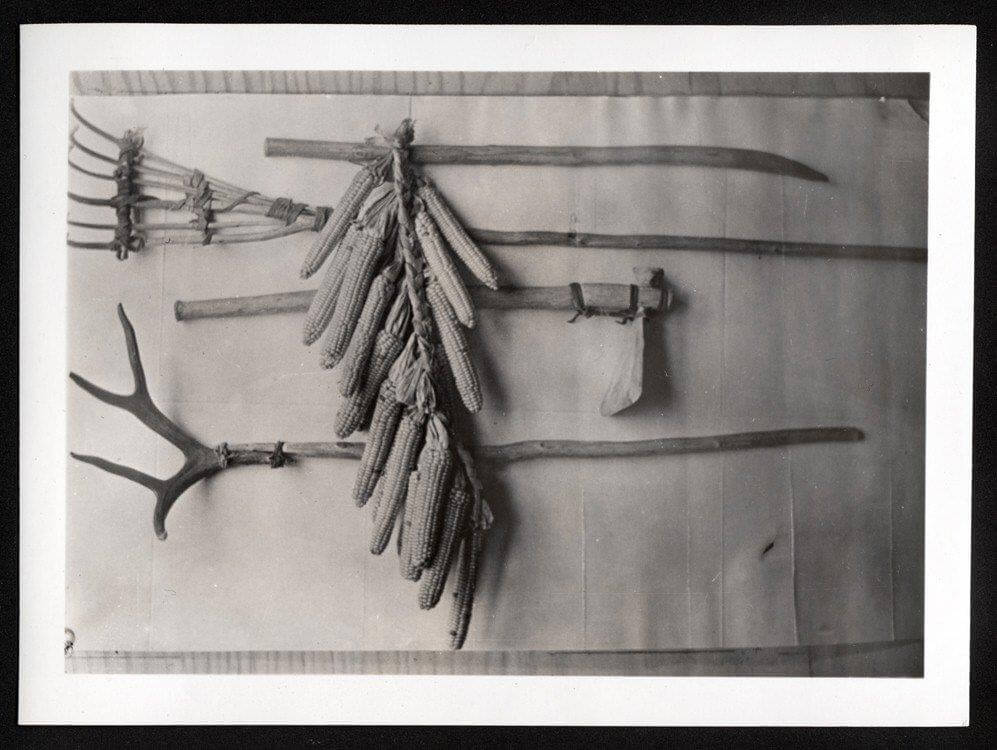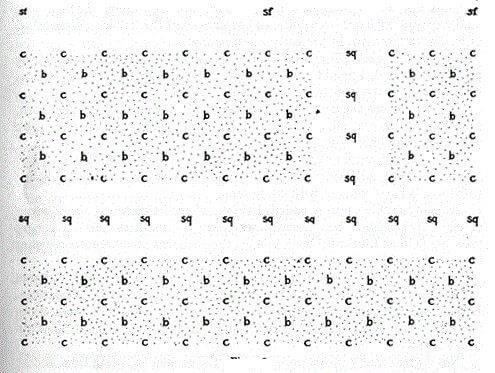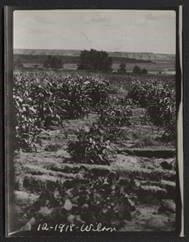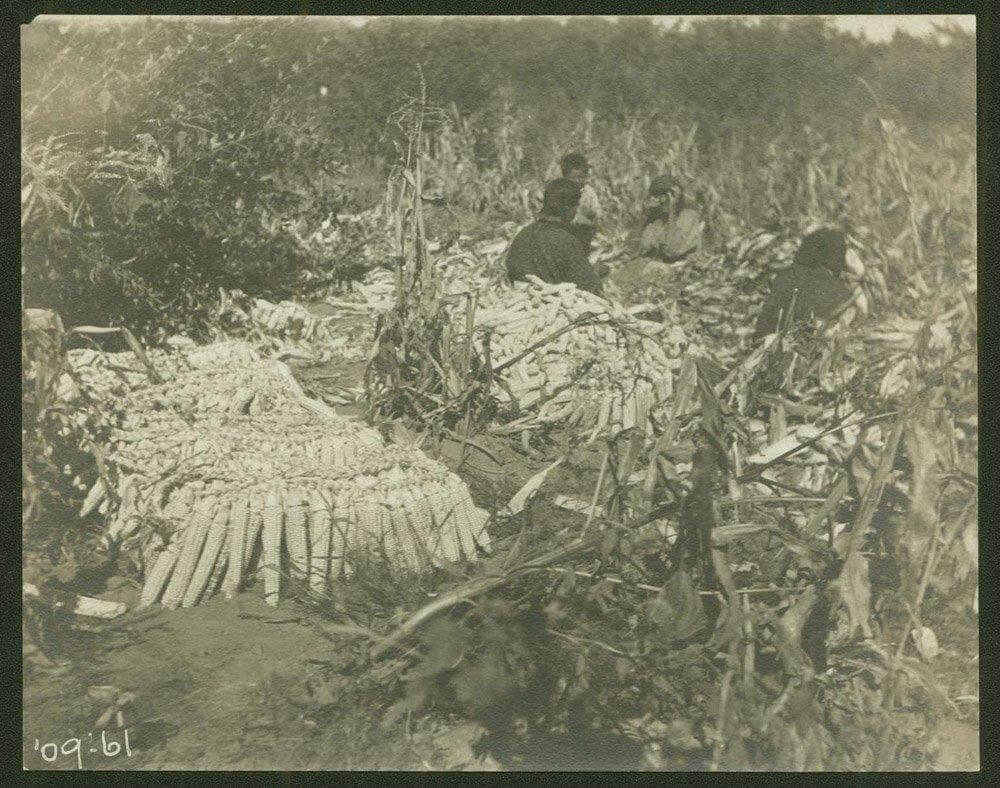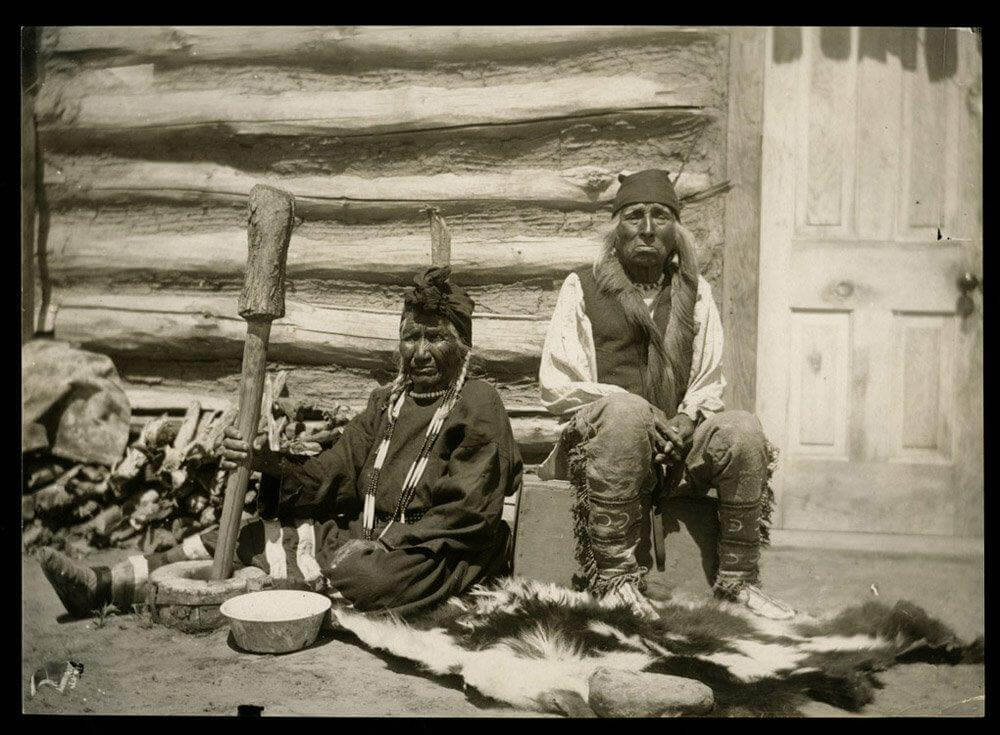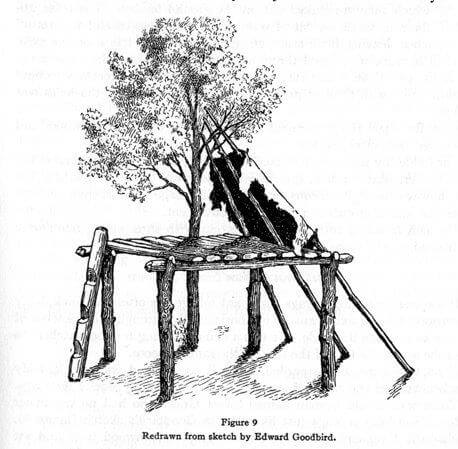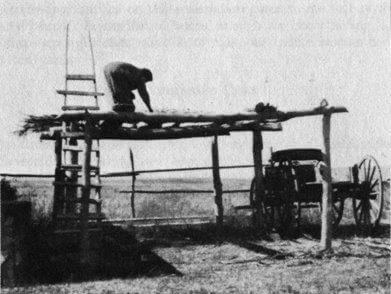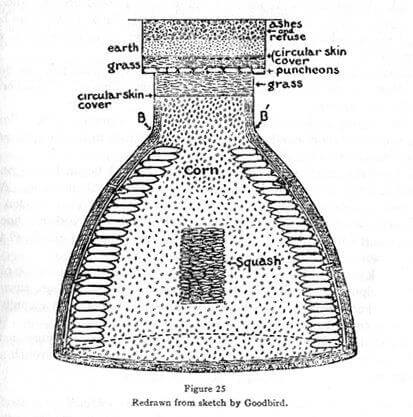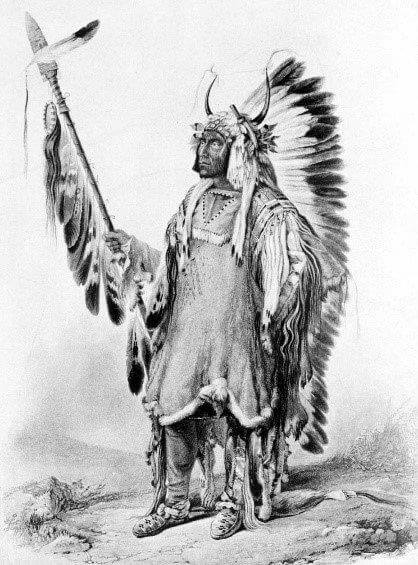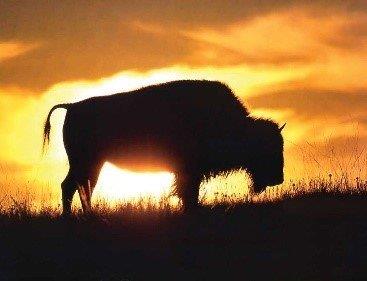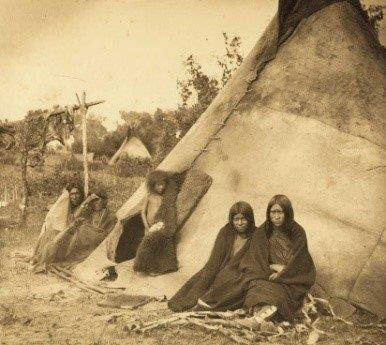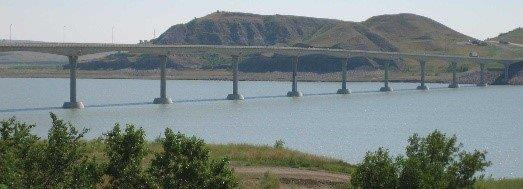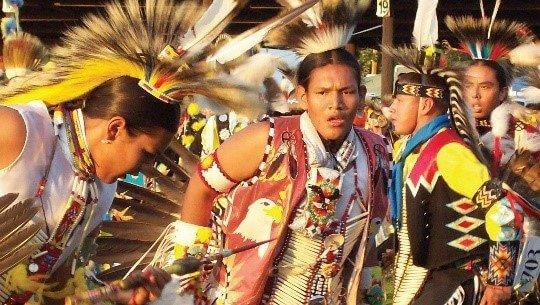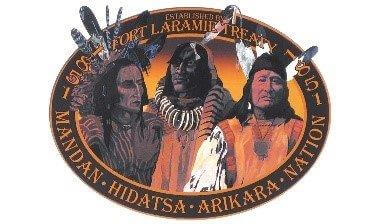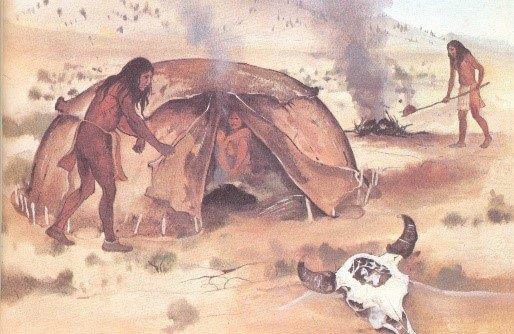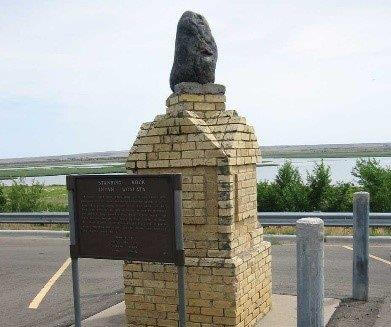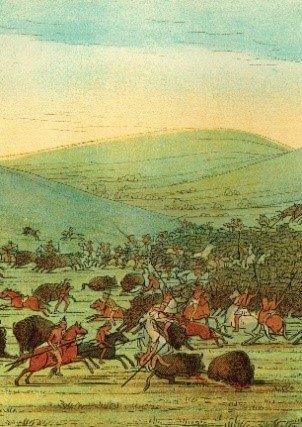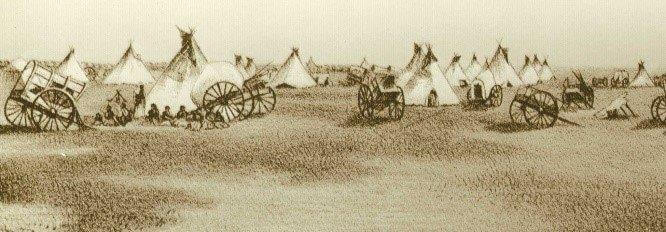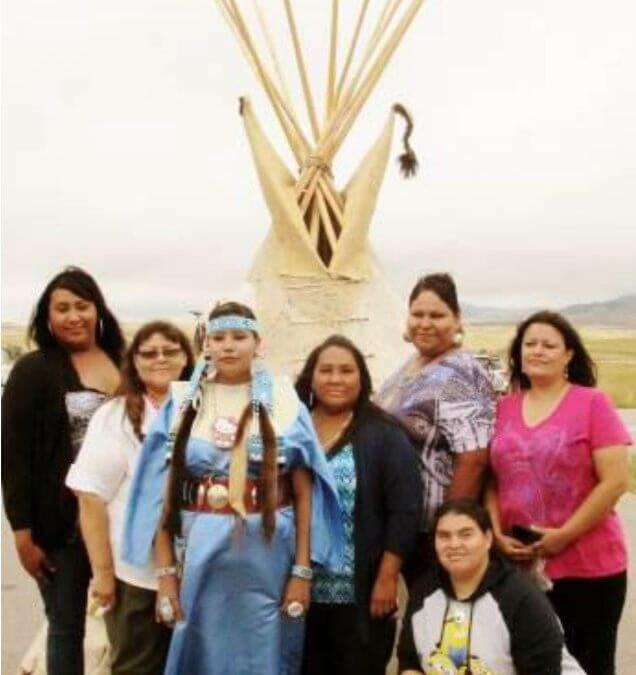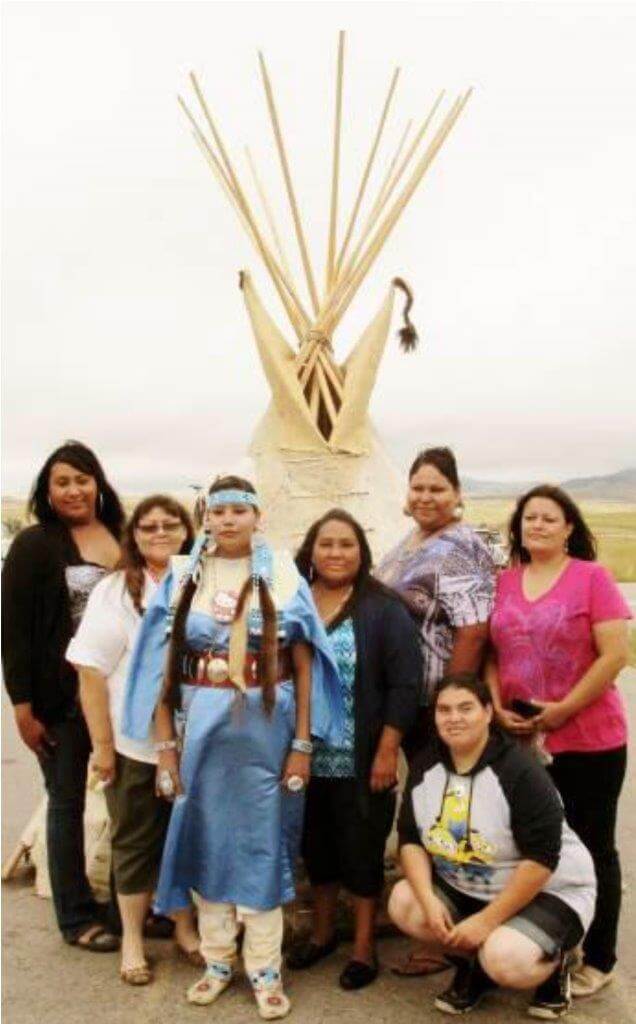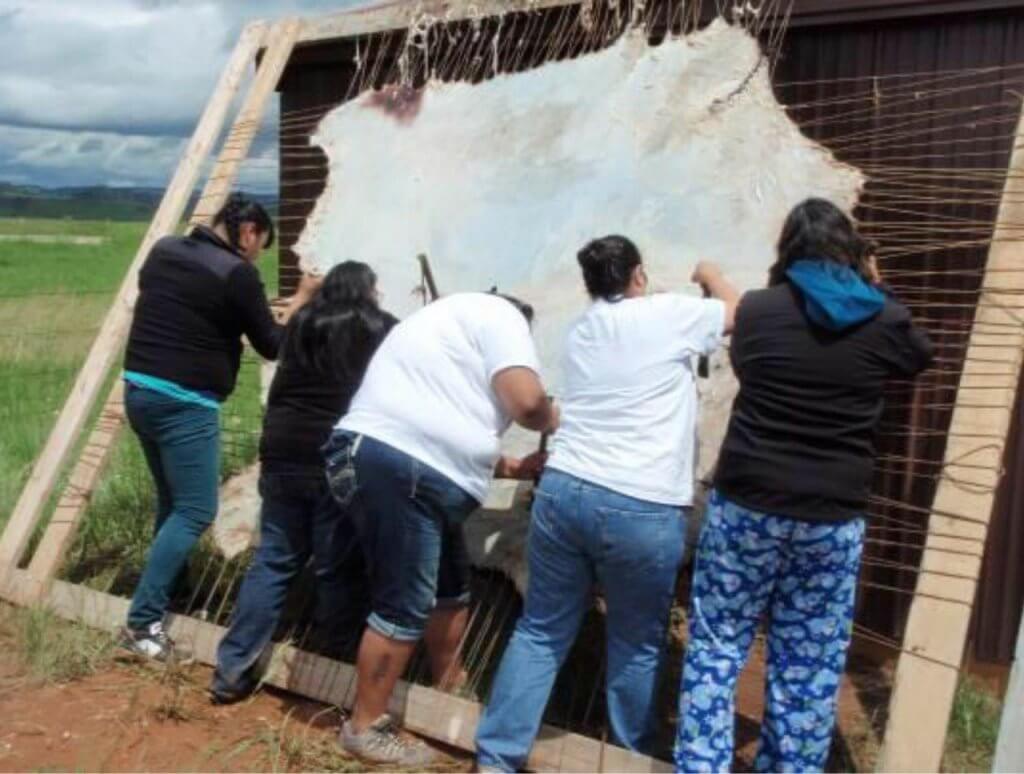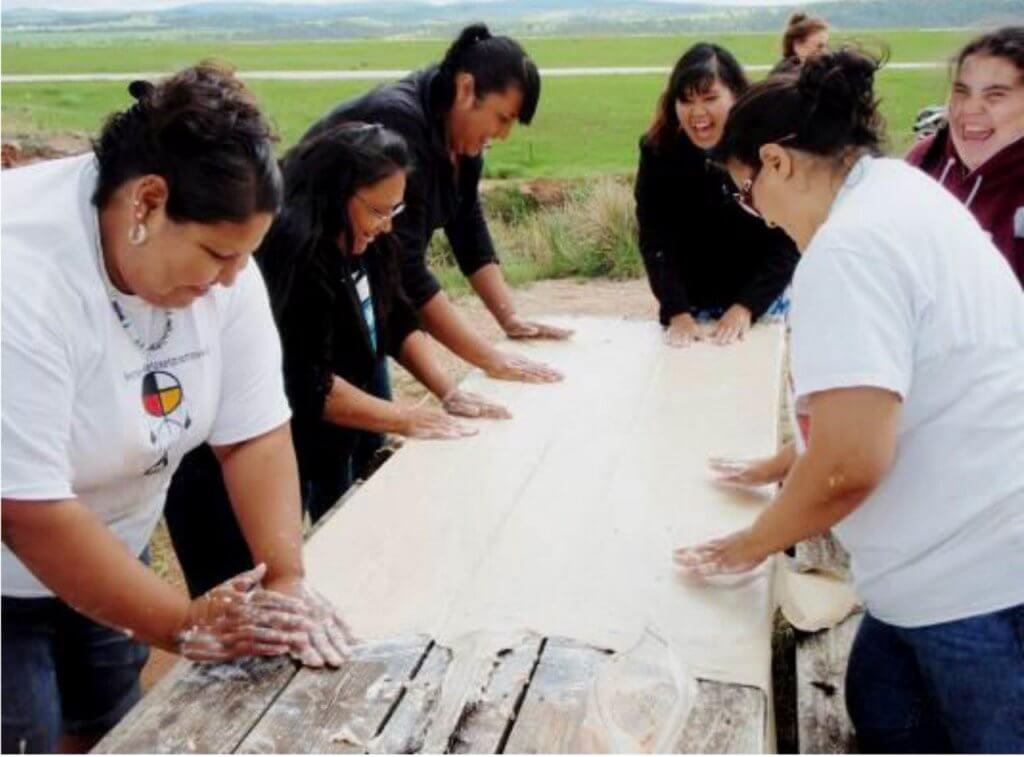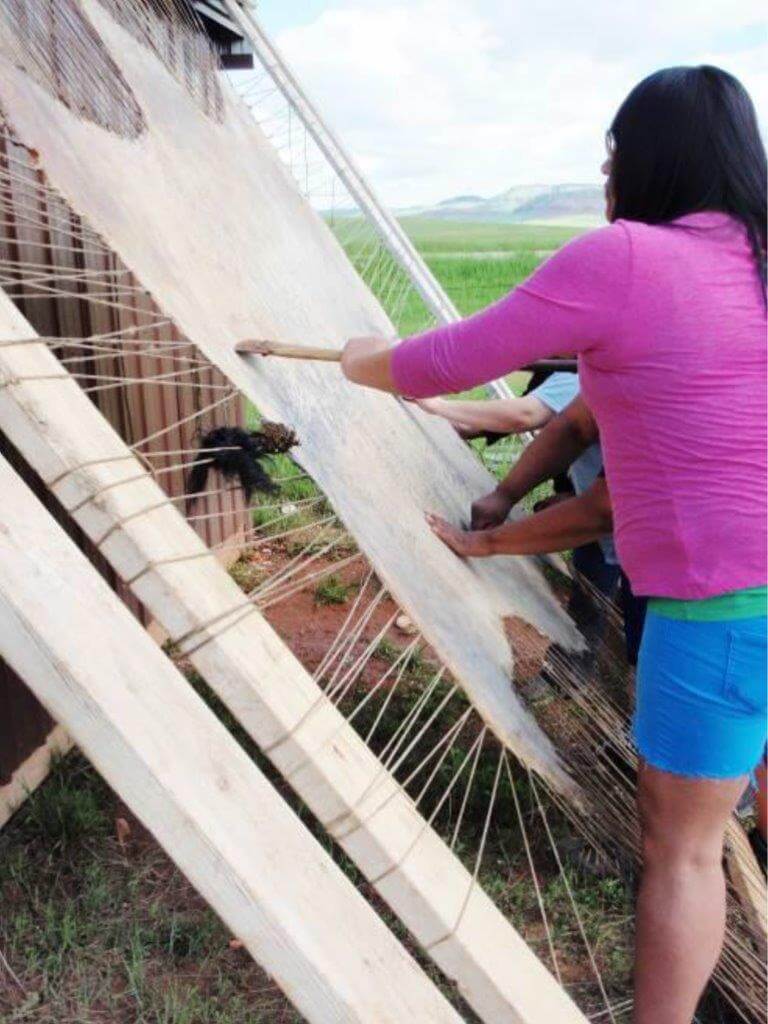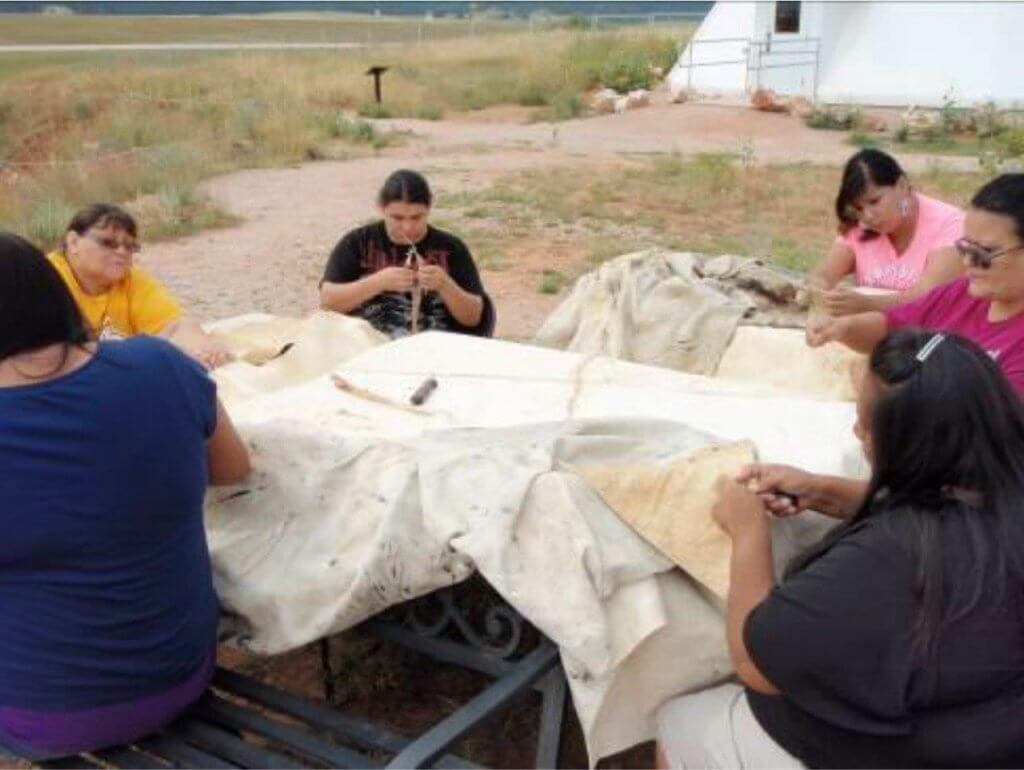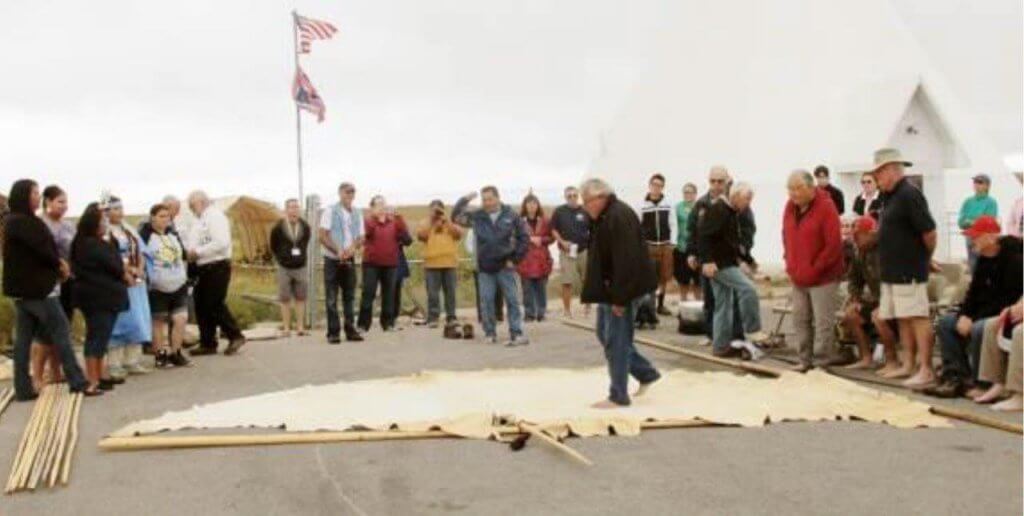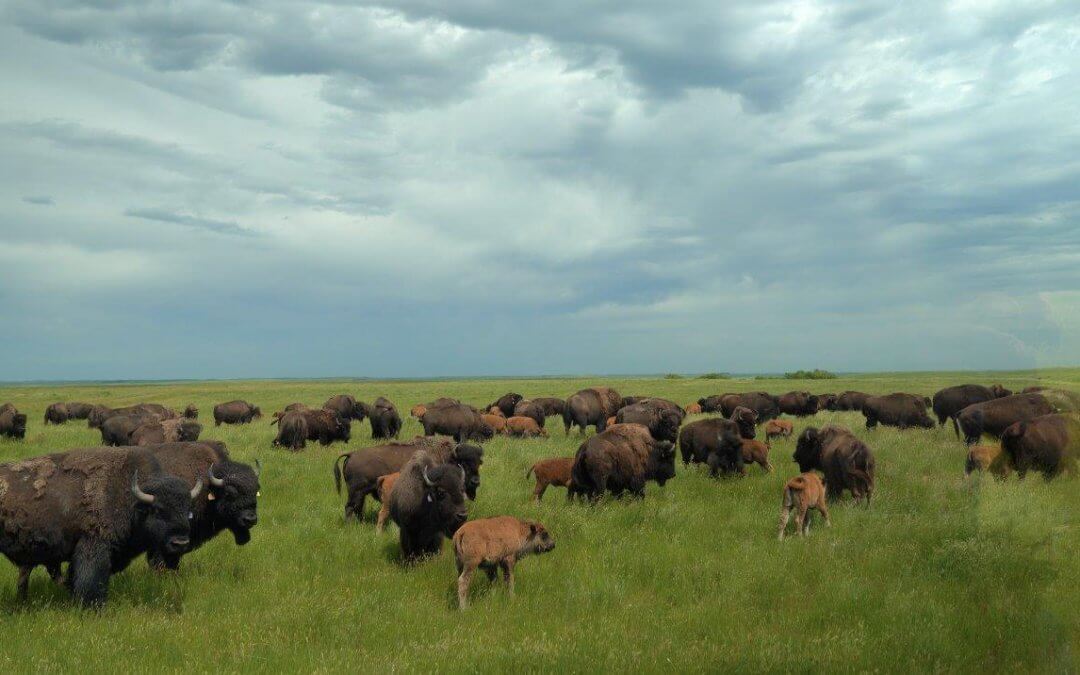
Part 3—Bison Hunting

All the tribes used bison hides, hooves, heads, horns, tails, bones and many internal organs to furnish the necessities for a comfortable life. Skulls and other parts were important culturally for religious ceremonies. Photo by James Kambeitz, Bismarck State College Bison Symposium.
Bison supplied immense quantities of meat for the tribes that hunted on the Great Plains.
Some of these tribes, including the Lakotas, Dakotas, Yanktonais, Chippewas, Mandans, Hidatsas and Arikaras, lived on the Great Plains.
Other tribes lived to the east in the woodlands of Minnesota or west in the foothills of the Rocky Mountains and traveled into the Plains every summer to hunt bison.
So important was this animal to the well-being of American Indian tribes that they organized themselves every summer to travel as far as necessary to find bison, kill sufficient numbers for winter food supply and carry the meat back home again.
These hunts required careful and exact organization. The tribe’s well-being depended entirely on a successful hunt.
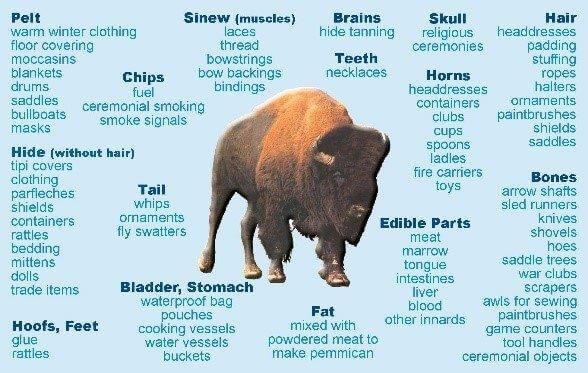
Some people have called bison the “grocery store” of American Indians. Perhaps “shopping mall” would be even more appropriate, because nearly everything the people needed and used was available from the bison carcass. Image by Cassie Theurer.
Bison was the raw material from which American Indians of the Great Plains made their living.
Bison provided meat, bones to be made into tools, hides for clothing, housing, bedding and containers.
Hunting required great skill and courage, but it also took skill to tan the hides, shape the tools and preserve the meat.
Both nomadic tribes such as the Lakotas and the sedentary tribes such as the Mandans hunted bison. All tribal peoples also hunted deer, antelope and elk. They also fished and trapped birds, but no other animal provided the food security that bison did.
In addition, all the tribes used bison hides, hooves, heads, horns, tails, bones and many internal organs to make the necessities for a comfortable life.
Parts of the bison were used to make toys for children, such as ribs for sledding.
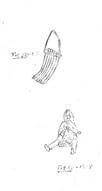
Gilbert Wilson asked Goodbird and Wolf Chief to draw pictures of the stories they told. These two images show how they made a sled from bison ribs joined by rawhide thongs. One or two children could sit on the sled and slide down a snowy hill. From Gilbert Wilson Reports 1914, Sketches. Courtesy Minnesota Historical Society and American Museum of Natural History.
During most of the year, any family or village that needed meat could go out to hunt bison, deer, elk or antelope.
However, the big summer and early fall hunts were conducted for the entire tribe. The summer hunt was organized by tribal leaders whose decision had to be obeyed by all members of the tribe.
Anyone who approached the bison herd without permission would be severely punished. Usually, one of the young men’s societies was given the authority to maintain order among the tribe so no one scared off the bison herd.
Hunts were often preceded by religious ceremonies such as the Sun Dance. During these ceremonies, the people made spiritual sacrifices to ensure a successful hunt.
For many of the tribes of the northern Great Plains, bison held a special spiritual significance.
The summer hunt was a good time for children to learn the important tasks of an adult. Girls learned to prepare food, mend clothing and pack for hunting camp. Boys learned to hunt and to obey the hunt leaders.
Many rules, skills and ceremonies were passed down from parent to child during the summer communal bison hunt.
My First Buffalo Hunt, by Wolf Chief
Wolf Chief was born into a Hidatsa family around 1850. As a young boy, he accompanied his father and other hunters on the summer hunt, though it was not yet time for him to participate in the hunt.
This was his first lesson in the work of adult men of his tribe.
More than 60 years later, Wolf Chief told the story of his first hunt to Gilbert Wilson, an anthropologist who recorded many stories of the old ways of the Hidatsa. The story has been edited slightly.
When I was about 12 years of age, all the people of our village went on the west side of the Missouri] River toward what is now the town of Dickinson, for we had heard that buffalo herds were there. We crossed the river in bull boats . . . .
My father, Son of a Star, was chosen leader of the hunt and Belly-up was his crier. We made our first camp just outside the timber of the Missouri.
The next morning our people struck tents . . . . The young men went along the side of the road on horseback. In old times when we made a march like this, a large number of the people walked . . . .
The season of our march was in the first part of July. Before we had left Like-a-Fish-Hook village, all the families had hoed their gardens free of weeds so that we could leave them in safety, knowing that our crops would be in good condition when we returned.
We made six or seven camps before we found any buffaloes. As we came near to Cannonball River, my father sent two young men ahead to see if they could find any buffaloes. They returned saying, “There is a big bunch of buffaloes over there.”
They made their report on returning that evening. Everybody got ready for the hunt the next morning.
We arose early in the morning and my father saddled two horses while I also saddled one, for I was going with the hunting party.
I had a white man’s saddle, small for a boy, which I had gotten from the Crow Indians. Both my father’s horses had elk horn saddles.
In the rear of his saddle he tied short ropes in a twist, like a figure eight. This was to be used to bind the meat on the saddle when we came home from the hunt.
The party was made up of about 40 men, each leading an extra horse and 8 boys of from 12 to 15 years of age, each riding a single horse only, not leading one. A boy of 16 or 17 was thought old enough to be a hunter.
The 40 men were young men, or men in their prime, that is, of hunting age.
With us boys, who did not expect to take part in the actual hunt, went 3 old men, one of them carrying a bow and arrows. I do not think he really expected to use them but carried them more for the sake of old-time customs.
The 3 old men and we smaller boys, were not expected to take part in the actual chase of the buffaloes.
The leader of the hunt had been appointed the night before. He was Belly-up, or E-da´-ka-tas. Our name for a leader of the hunt was Matse´-aku´-ee, or, keeper of the men.
The name for my father’s office, leader of the tribe on the march, we called Madi-aku´-ee or tribe-traveling keeper.
Belly-up went on ahead and all the rest of us followed. We went out about five miles. Then we sent out two men on ahead . . . to spy out the herds.
We went at a smart trot. Pretty soon we saw our two scouts returning. They reported to Belly-up that they had located the herds.
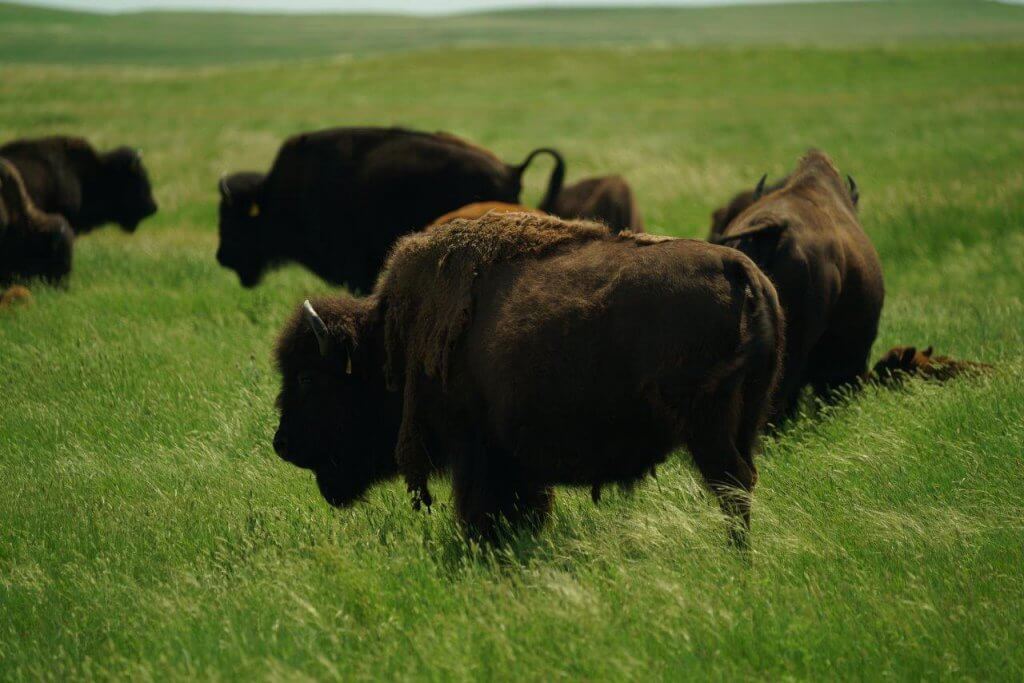
The herd went tearing off. Only a fast horse could overtake buffaloes and indeed, a fleeing buffalo could outrun many speedy horses. “We killed only cows. The flesh of the bulls was tough,” reported Wolf Chief. Photo JK, BSC Bison Symposium.
They returned at a gallop, so we knew before they had reported, that they had news to tell. Belly-up now pressed forward faster and we all followed at a gallop.
All the men had quirts, as had Belly-up himself and I remember how the quirts would come down, “Slap, slap,” on the horses’ flanks and the hoofs go “Beat, beat” on the stones.
About a half mile from the buffaloes we stopped on the hither side of a hill which hid the buffaloes from view. The men took the saddles off the horses they were riding and put bridles in their mouths made of raw hide ropes, then remounted.
Belly-up went off a little way, took out a piece of red calico, tore off a strip and tore it into three or four pieces. These pieces he put on the ground as he faced in the direction of the buffaloes.
He spoke something, evidently a prayer. I could not tell what he said, but I knew that the red cloth was a sacrifice to the buffaloes.
Everybody now got ready and the men mounted their horses and stood in a long line facing the buffaloes, with Belly-up on the extreme right.
Of course, I mean only the hunters. The line now started forward at a sharp gallop, with all the heads and necks of the horses even, in a long line.
A soldier Indian, a man named Tsa-was, rode in front, and if any man got too far forward in the line, Tsa-was, or “Bears Chief,” would strike the horse in the face.
We boys had to follow behind with the 3 old men. These were old men of about 60, or more. One of them, as I have said, had his bow and arrows along, but all the young men in the hunters’ line had rifles. We were all on the leeward side of the buffaloes.
As we came over the brow of the hill we sighted them about four hundred yards away. Belly-up gave the signal, “Ku kats! Now’s the time!”
Down came all the quirts on the flanks of the horses, making the ponies leap forward like big cats. Everyone now wanted to be first to get to the herd and kill the fattest buffalo.
I was somewhat scared, for the horses were at break-neck speed and my pony took the bit in his mouth and went over the rough, stony ground at a speed that I feared would break his neck and mine too.
“Bang!” went a rifle. A fat cow tumbled over.
“Bang! Bang! Bang! Bang!” The herd swerved around and started up wind as buffaloes almost invariably did when they were alarmed.
The herd went tearing off. Only a fast horse could overtake buffaloes and indeed, a fleeing buffalo could outrun many speedy horses.
We killed only cows. The flesh of the bulls was tough and that of calves, when it was dried, became soft and was easily broken into pieces. For this reason, we did not often kill calves, although we sometimes did for the skins.
My father had killed three fat cows in the hunt, for he was along with the party. He butchered the cows and brought his spare horse (which he had left behind the hill, hobbled) and loaded it with meat.
He put a little of the meat also on the horse that he rode, but none on the pony I rode.
As he was cutting up the carcass, I saw him throw away what I thought was a good piece of meat.
I hated to see that piece of meat wasted and when I thought he was not looking, I picked it up and threw it back on the pile.
When we got home, I overheard my father say to my mother, “Our boy is not a wasteful boy—he wants to save what he has. He threw back on the pile of meat, some tough leg meat that I had thrown away. He did not want to see it wasted.”
He returned back to the camp from the place of the hunt much more slowly than we had gone thither. Sometimes we went at a trot, very often at a walk.
Almost every part of the buffalo was used in the old times. The choice cuts, with the shoulders and hams, we carried home, but the spines, neck, and heavier pieces we left behind on the prairie, covered over with hides.
The next day we came back to the place of the hunt for the meat we had left behind. We found it safe and carted it back to camp.
We spent two days drying the meat and making bone-grease. We did not dry the meat in smoke but on stages in the open air.
The tribes used different techniques in hunting. Some drove bison herds over a cliff or into a small canyon. Others surrounded the herd and then approached for the killing.
As soon as the bison were killed, women removed the hides and began to cut the meat into pieces. Usually some of the meat was consumed immediately as the tribe or band celebrated a successful hunt, but hundreds of thousands of pounds of meat were dried for winter use.
Women sliced the meat into thin strips and hung it on poles in the sun near a small fire to dry. Dried meat did not spoil.
Many of the tribes dried the meat at the hunting camp before returning to their villages. While the meat was drying, the hides were stretched out on the ground and staked down.
Women then scraped the hides clean of all flesh and began the process of preserving the hide. Hides might be tanned for robes. Other hides might be left untanned and used as rawhide.
Hunters broke open the bones to remove the marrow which was eaten fresh or used in soups. Marrow is high in calories and protein, so it was a highly valued food. The bones were saved to be made into sharp, strong tools.
Following the summer hunt, the people returned home with many tons of dried bison meat. If they were able to protect their supply of meat from raiders or military attack, they would eat well until the following spring.
This document is presented with permission of the Minnesota Historical Society and American Museum of Natural History. From Gilbert Wilson’s Reports, 1913, part 1, pgs 125-141.
Lakota Bison Hunt
The Lakotas lived in the woodlands east of the Great Plains where they lived as both hunters and farmers until around 1707.
The winter count of Battiste Good tells us that by 1707, the Lakotas had both horses and guns. They acquired guns and horses through trade networks that linked Indians to European Americans.
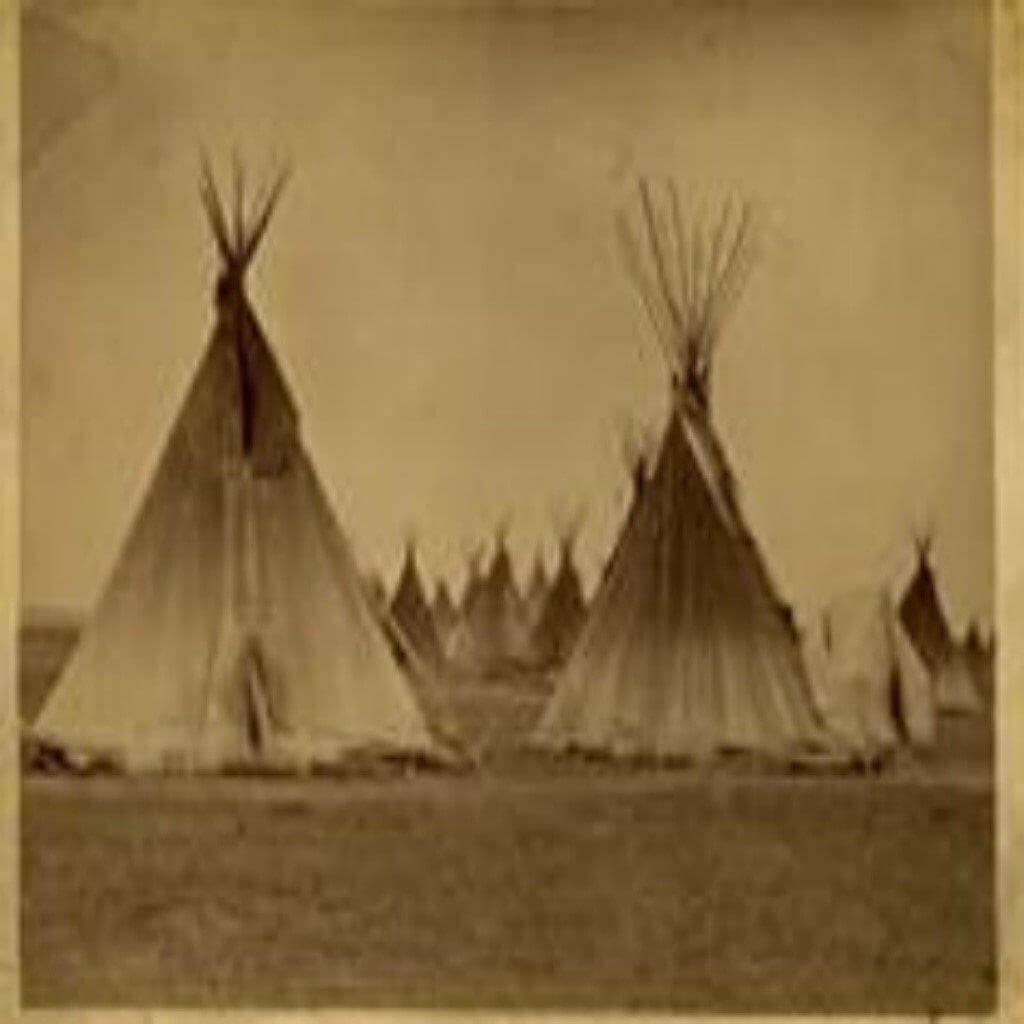
Lakotas lived in tipis that could be easily transported from one camp to another. This mobility suited their bison hunting economy. A small camp like this would have been set up near the place where the Lakotas were hunting bison. The people would work very quietly in a hunting camp. The tops of the tipis are dark with smoke from the cooking fires. SHSND 10190-84-01-16.
By the middle of the 18th century, the Lakotas were primarily bison hunters. They hunted for food and hides.
The surplus in hides was traded to other tribes or to Anglo-Americans for other things they needed. Women prepared the hides for trade by stretching and tanning the hides.
They also decorated the hides in order to get the best advantage in trade. In the late summer or early fall, Lakotas traveled to the Mandan villages to trade bison hides for corn which they needed for a good diet.
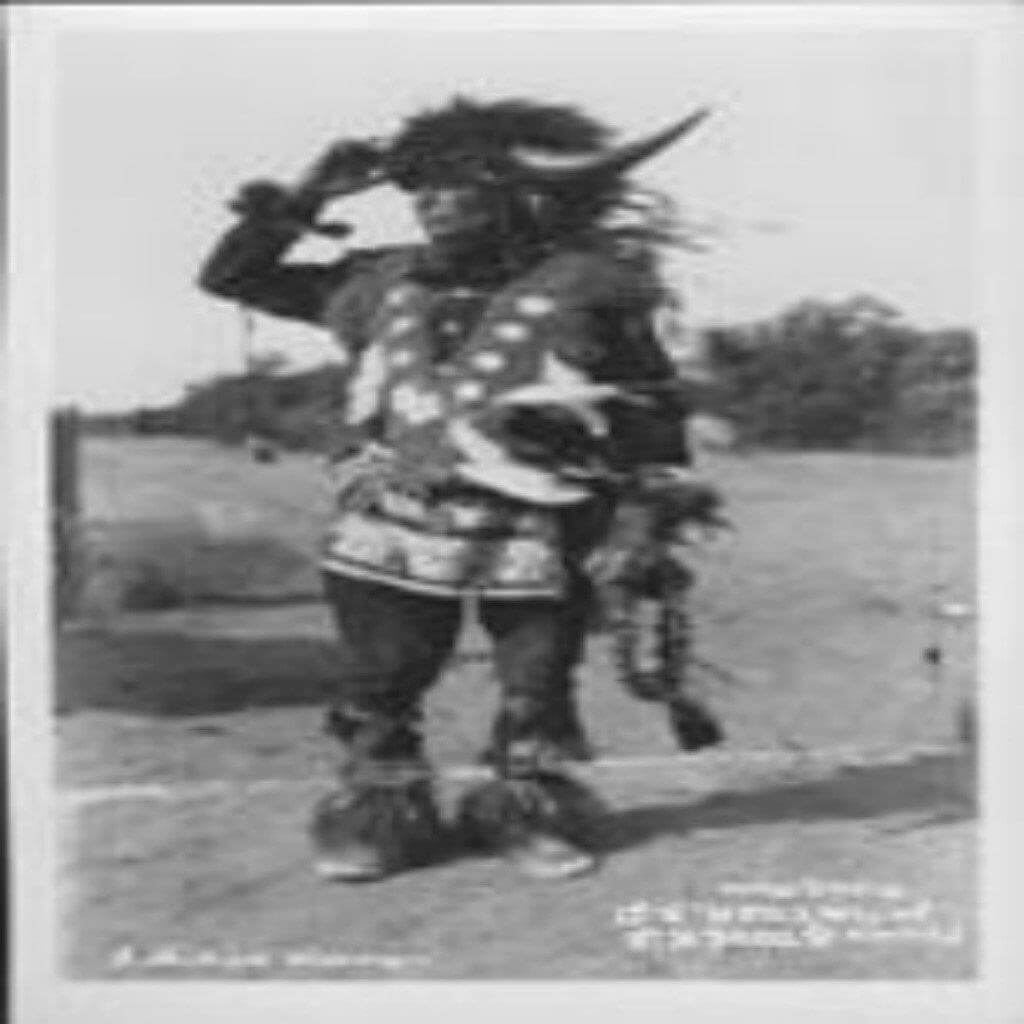
This man’s regalia, ceremonial clothing, reflects the spiritual importance the Lakotas gave to the bison. His headdress was made from the head and horns of a bison bull. The vest, wrist bands and ankle bands were made from bison hide. SHSND 1952-6244-01.
As the time for the communal hunt approached, the Lakotas began making plans. The hunt could not take place until a spiritual leader had a vision.
The vision might tell the people that the time to hunt was right, or it might tell them to wait a while. Either way, the people listened carefully to the advice and followed it.
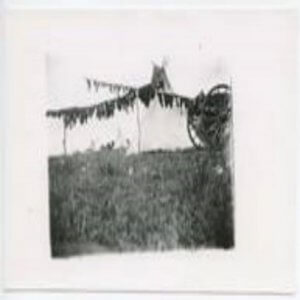
After the meat was removed from the bison carcass, it was hung to dry on a rack near a fire or in the sun. The dried meat could be stored for a long time. Some was pounded into powder and mixed with bison fat and berries to make the nutritious wasna or pemmican. SHSND 1952-7166.
After the proper spiritual ceremonies had been completed, the council met to discuss the hunt. The council members smoked a pipe in the appropriate ceremonial manner and carefully discussed the hunt.
They decided when and where the hunt would take place. The discussion might have lasted a few hours or several days. The council ended with a great feast prepared by the women of the village.
Before the hunt began, the council chose four young men to organize and maintain order in the hunt. These men were called akicitas (ah kee CHEE tahs) or marshals. Each of the marshals wore a special shirt and carried a feathered banner to signify his role. The akicitas controlled the camp and had the authority to punish anyone who disobeyed.
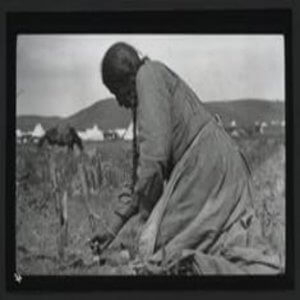
This Lakota woman demonstrated how to flesh a fresh hide. She is using a small hide, perhaps from a deer for her demonstration. However, her technique is the same as for a bison hide. The hide was stretched and staked to the ground. The woman used a bone scraping tool, wrapped in rawhide, to remove the fat, connective tissue and remaining muscle tissue from the hide. SHSND 0270-0110.
Before the hunt, women prepared to move the camp. They made repairs to the tipis, harnesses and clothing.
The men prepared their bows and arrows and bison hunting horses for the hunt. They also played a game called hehaka (heh HAH kah) which was a game of speed and accuracy that involved catching a hoop with a stick.
The entire village traveled between 10 and 25 miles each day. Even very small children, elderly people and those who were sick went with the village on the hunt. They stopped where there was enough water and wood for a good camp.
The people traveled close together and kept watch for enemies. The season for the Lakotas’ hunt was the time when all tribes were out to hunt bison.
When the camp arrived at a place near the herd, the people, even children and dogs, had to be very quiet so the bison herd would not be frightened.
When the scouts discovered a herd, they returned to signal the hunters. Different signals meant different size herds. If the scout waved his robe, then spread it on the ground, it meant that he had seen a herd (Battiste Good Winter Count).
First, the Lakotas made an offering to the spirit of the bison. The camp herald went through camp calling everyone to make ready for the hunt.
At first light, the marshals led the hunters silently toward the herd and arranged them so each had a fair chance.
At the signal, the hunters galloped toward the herd, keeping low on their horses. The bison, not seeing humans, did not run until the hunters released their arrows.
The hunters tried to wound or kill as many as possible. They shot an arrow into the bison’s side or chest. An animal that was wounded, but not killed might turn and charge the hunter’s horse.
The hunter quickly left the first bison he shot and rode after another. They continued until the horses were exhausted or all the bison they wanted were killed.
If there was a white bison in the herd they made a special effort to kill it. White bison were rare and considered wakan (wah KAHN) or sacred.
A white bison robe made an extraordinary gift or offering. One of the bison carcasses, perhaps a white one, was sacrificed for a good hunt. The hide was removed from the carcass, but the remainder of the animal was left in the field as a sacrifice of thanks.
Each hunter identified the animals he had killed with some mark or piece of clothing. Soon the women arrived with horses and travois for carrying the hides, meat and other parts back to camp.
The hunters took a fresh liver, dipped it in gall (a bitter fluid from the gall bladder) and ate it. Lakota hunters believed that this food, eaten raw, gave them strength and courage. Roasted meat was served to the rest of the village.
Women now dried the meat, stored the fat and made wasna (WAHZ nah). They staked out the hides. The men rested.
After all the meat was dried and preserved, the tribe decided if they had enough for the winter or if they needed to conduct another hunt. If they did not need to hunt anymore, the marshals gave up their control of the camp and life returned to normal.

The Lakotas chose to live as nomads, hunting and trading, which provided them with a good living and a strong spiritual foundation. But this life demanded they be constantly prepared for an attack or war with enemies.
Bison provided everything necessary for a good life on the Great Plains. The Lakotas chose to live as nomads, hunting and trading, which provided them with a good living and a strong spiritual foundation.
However, this life also required that they be constantly prepared for an attack or war with enemies.
ND Studies 8th grade
______________________________________________________________________________
NEXT: PART 4 ME’TIS: The Métis Bison Hunt, with Father Belcourt

Francie M Berg
Author of the Buffalo Tales &Trails blog
